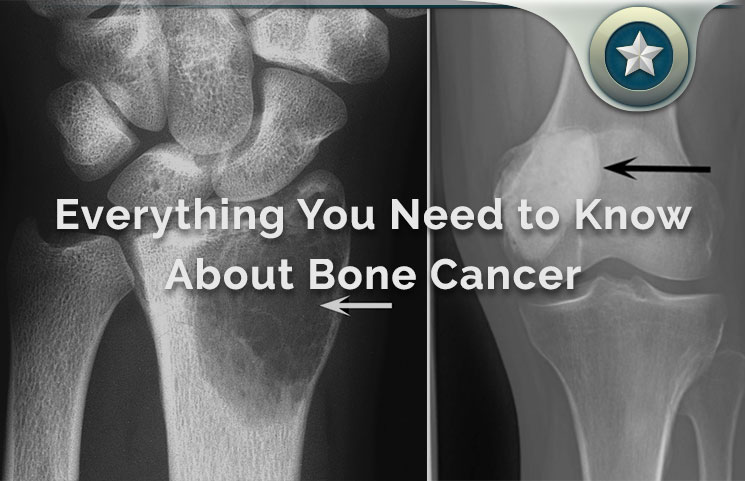Cancer… we all dread that diagnosis. It’s like a death sentence, usually with a time frame of course. If you’re reading this, chances are that you’ve just had a close call with the dreaded condition either personally or through someone close to you.
The good news is that thanks to technological and medical advancements, cancers can be treated and patients can go into complete remission. Often times though, this is often contingent on many other factors. That said, let’s dive into one of the less common cancers –bone cancer.
About Bone Cancer
Bone cancer is one of the rarer cancer types, and only occurs in less than 1 percent –approximately 0.2 percent- of all cancer cases. This often presents as a malignant tumor arising from abnormally grown cells that latches itself onto or grows from the bone cells itself, and destroys your bone’s cells.
This malignant tumor is often different from benign bone tumors which are usually noncancerous and grow at a slower rate than the malignant ones. There are more benign bone tumors than there are the malignant ones.
Unfortunately, both tumor types can actually affect your bone’s health, which is why a bone biopsy or scan is essential as soon as a tumor is diagnosed.

The key difference between both benign and malignant tumors is that benign tumors are not metastatic, do not damage bone tissue, and pose no real danger to life. It is important to note that when it comes to cancers, there are two types of malignancies that can be found in the bone:
- Primary bone cancer
- Metastatic cancer
Primary bone cancers are caused by from abnormally growing bone cells. Metastatic cancers on the other hand, are malignancies starting in other parts of the body and spreading to the bone. These are often named after the primary organs.
For instance, if a cancer starts from the prostrate and metastasizes to the bone, it is actually called prostate metastatic cancer or bone metastasis even if tumors are found in the bone. This is why doctors often need to carry out proper diagnosis to determine the original source of the tumor before commencing any treatment protocols.
Because of its rare occurrence –it only occurs in less than 1 percent of all cancer cases both nationally and internationally- doctors often need to confirm its origins before commencing treatment. In fact, it’s estimated that the cancer only occurs in 1 out of 100,000 individuals.
People who suffer from bone cancer tend to experience bone displacement as one of their symptoms.
The Difference between Benign Tumors and Malignant Tumors
Before we proceed, it is imperative to understand the difference between these two tumors. If you already know the difference, feel free to skip this part. Otherwise, it’ll take only a few seconds to go through it:
-
Benign Tumors
Benign tumors are usually non-cancer tumors that can occur in any part of the body. They have the following characteristics:
- Tend to be restricted to local body parts
- Do not spread to other parts of the body –they don’t metastasize
- Grow slowly
- Don’t invade other body parts or organs
- Covered or encased in a “sac”
- May not be life threatening –this is often dependent on where it’s located. Benign tumors located in major passages like the airways, throat, kidneys, colon and anal region can become quickly dangerous if left to grow to significant sizes.
- Can be removed without threat to life or tendency to return
However, just because they are non-cancerous doesn’t mean they cannot affect or adversely reduce your quality of life. The pressure from benign bone tumors for instance, can affect your bones, resulting in significant discomfort, broken or even fragile bones.

-
Malignant Tumors
Malignant tumors are usually cancerous and are often caused by cells growing at an abnormal rate. They have the following characteristics:
- May or may not cause discomfort
- Can be harmful and life threatening
- Has the tendency to spread to other parts of the body
- Can be aggressive or non-aggressive
- Can be invasive and isn’t encased in any “sac”
- There are chances of a resurgence even after the tumor is removed. This is called a relapse
Types Of Bone Cancer Tumors
Even though we briefly touched on the two broad bone cancer categories previously, we’ll be exploring each category in-depth in this section:
-
Primary Bone Tumor
There are often two key sources of these tumors:
- Bone tissue tumor
- Bone affiliated tissue tumor
The first is directly from only bone cells and structure. The second is from structures and tissues associated or affiliated with bones. Examples of these include tendons and ligaments. Examples of malignant tumors originating from bone tissues include osteosarcoma, chondrosarcoma and fibrosarcoma.
Examples of bone affiliated tissues include Myeloma, reticulum cell sarcoma of the bone, Ewing’s sarcoma, and notochordoma. As with all cancers, they are often considered easier to treat when they are still localized and restricted to just the bone.
-
Metastatic Tumor
Metastatic bone cancer is often very dangerous because it can be hidden and confusing. Unfortunately, if the symptoms aren’t detected quickly, it can be too late for the patient. Metastatic tumor’s origins are usually from other organs and parts of the body.
The problem with this is that tumors that break away and attach themselves to the bone or other parts of the body tend to do so when their “food source” is diminished at the primary source and they need to find another organ to attach to in order to replenish their nutrition and spread more rapidly.
When the cancers attach to the bone, they are labeled as metastasized bone tumors or secondary bone cancer. These are often dangerous because they can be located far away from the primary source of the cancer.
It’s almost as if the cancer cells are “intelligent”, and often do this to ensure “self-preservation” in the event of an “attack” usually in the form of treatment. It is important to note that secondary bone cancers can be caused by just about any cancer type.
Some of the more common cancer cells that tend to evolve and become secondary bone cancers include thyroid cancer, lung cancer, breast cancer, prostate cancer and kidney cancer.

Types Of Primary Bone Cancer
Now that we’ve talked about the possible bone tumor types and how different they are, it’s time to examine the primary types of bone cancers.
-
Chondrosarcoma
This usually starts in the cartilage which is what pads your joints’ heads and ends. Its most common point of origin is in the shoulder, upper leg, and pelvis. There are instances where chondrosarcoma has malignant cancer cells.
Whenever this happens and is identified, your oncologist will most likely diagnose the cancer as an osteosarcoma. This is more commonly found in adults above 40 years old, and seems to become even more likely with age. Children and young adults rarely develop this cancer.
-
Osteosarcoma
There’s a tissue in your bones called the osteoid tissue. When malignant cancer cells arise from this tissue in the upper arm and knees, oncologists diagnose the condition as Osteosarcoma. This is commonly seen in patients between the ages of 10 and 19, and those above 40 –particularly those suffering from Paget’s disease.
-
Ewing Sarcoma
This is more accurately called the Ewing Sarcoma Family of Tumors (ESFTs). This is often detected in bone tissues, but usually has its origins in surrounding cartilages and soft muscle tissues.
This cancer is usually found in parts of the body like the arms, legs, pelvis and backbone. They are often diagnosed in people younger than 19 years and seems to be more commonly found in Caucasian males than females.
What Causes Bone Cancer?
Often, the key to effective cancer treatment lies in knowing its causes. Unfortunately, bone cancer’s causes are still largely undermined.
This is probably because it is rare and only affects a small percentage of all cancer patients –roughly 2,300 patients are diagnosed every year. There are however, a few possible bone cancer risk factors that health researchers have identified as possible causes and triggers of the cancer.
- Prior exposure to cancer treatment. People who have been treated for cancer in the past, particularly through radiotherapy, tend to develop osteosarcoma. However, this seems to show up more in children.
- Hereditary factors also play a critical role. Studies have shown that children with hereditary retinoblastoma, are more likely to having osteosarcoma particularly when they have had previously undergone radiotherapy. Also, individuals with metal implants and bone defects are more susceptible to it.
- Other risk factors for osteosarcomas include height (abnormally tall people seem to be at higher risk), weight at birth (people with heavier than average birth weights), race (Caucasian are at higher risk than African Americans), individuals suffering from Maffucci’s Syndrome and Ollier’s disease, and presence of benign tumors. Risk factors that can increase the odds of getting ESFTs include those born with congenital umbilical hernia.

Ultimately, medical researchers are still trying to accurately determine what the major causes could be like they have done for lung cancer, breast cancer and prostate cancer.
Symptoms Of Bone Cancer
One of the reasons bone cancer is considered dangerous and mostly caught late is because its symptoms mimic thousands of other health conditions. The one consistent symptom is consistent pain. Please note that this doesn’t happen in all bone cancer cases.
However, another common symptom appears to be swelling near, in or around a bone. As you can see, these are very general symptoms and can be easily confused with many other conditions like joint pains, arthritis and regular joint inflammation. This is why you have to visit the hospital to get a proper diagnosis.
Bone Cancer Diagnosis Process
As soon as you start noticing consistent pains and swelling in or around the joint area, get to the hospital and have your doctor look at it.
If they suspect that you have bone cancer –based on your medical history and so on- they will order for some tests to accurately determine if they are right. The process of bone cancer diagnosis often involves one or more of the following:
-
Biopsy
Depending on where the tumor is located and its ease of access, the doctor can order a biopsy of the tumor. This simply involves getting a small sample of the tumor tissue, which is then run through a few tests to ascertain the presence of cancer cells, if any.
This often involves either the use of needles or incision. If your doctor decides to do a needle biopsy, he’ll have to make a very small hole in the affected bone, insert the needle-like equipment and extract some tumor samples.
If he’ll be doing an incisional biopsy, all he has to do is simply excise a small part of the tumor and collect the samples he needs. This is often done by an orthopedist who will then send the samples to a pathologist for testing and results.
-
Blood Tests
Blood tests are usually ordered to determine the amount of alkaline phosphate present in your bloodstream. High levels of alkaline phosphate in the bloodstream often indicates healing –particularly when broken bones are healing, during rapid growth in children, and the presence of unusual bone tissue growth. This is usually ordered in combination with other tests in children, because of the aforementioned scenarios.
-
X-Rays And Scans
These will help identify where the tumor is located, how big it is and its shape. The first thing the doctor will order are x-rays. With that, they can often tell the next step to take seeing as it would give them an insight into the nature of the tumor.
Usually, doctors can determine if the tumor is benign or cancerous from its shape. After this, they can order a CAT scan, bone scan, MRI, PET, or an angiogram. Each of these scans are designed to help provide accurate diagnosis before the commencement of treatment.
Once it is determined that your tumor isn’t benign, they’ll talk to about treatment options. These will be dependent on the stage of the cancer -1 to 4-, possibility of metastasis or not, current health state, tumor size, location and so on.
Treatments For Bone Cancer
Treatment for bone cancer can either be one or a combination of treatment protocols that will help improve your odds of beating the bone cancer. Conventional treatment protocols often include radiotherapy, chemotherapy, surgery and/or cryosurgery.

-
Radiotherapy
Patients often have to undergo exposure to high energy x-rays targeted at the specific areas of the body with the tumor. This is commonly used in the treatment of chondrosarcoma and ESFTs, and may also be combined with surgery or used as an alternative.
-
Chemotherapy
This is usually non-invasive and may be used either as a standalone treatment option or combined with other treatments. Chemotherapy often involves using potent anticancer drugs who kill off the cancer cells.
While this is sometimes used in the treatment of osteosarcoma, and ESFTs, it’s not used for chondrosarcoma. Chemotherapy often has somewhat drastic side effects as it basically kills off most of the body’s cells during the course treatment.
This is why you’ll most likely be placed on a cocktail of meds to help aid your recovery and the production of healthy cells.
-
Surgery
This is usually the go-to treatment protocol for bone cancer. The surgeon goes to work in the malignancy and attempts to get everything out completely. The goal is to do so with negative margins –this means removing all cells so there’s none found around the edges of the tissue.
Your surgeon will be meticulous about this procedure and will do his/her best to ensure that little or no healthy tissue is removed in the process of cutting out the tumor. Thanks for modern medical tech advancements, bone cancer procedures are now a lot safer and requires less drastic measures such as amputating the affected limbs.
Please note that many bone cancer patients may require reconstructive surgery to help improve limb function afterwards.
-
Cryosurgery
This is an alternative option for surgery. Patients can opt for this instead of surgery. It involves the application of nitrogen to freeze the tumor, thus killing the cancer cells in the process.
Post Treatment Procedures
Patients are often monitored for improvements and progress after the initial round of treatments. Those in complete remission may only go for periodic checkups, while those whose tumors weren’t completely eliminated may have to undergo a repeat treatment.
It is important to adhere to these checkups to ascertain that there’s no metastasis to other parts of the body –bone cancer cells tend to metastasize to the lungs, ensure there’s no recurrence or the development of another cancer type –children treated for bone cancers are often at risk of developing leukemia in the future.
The good news is that the five year survival rate for bone cancer patients without any metastasis is pretty high (60-80 percent). Metastasis drastically reduces the odds to 15-30 percent.









